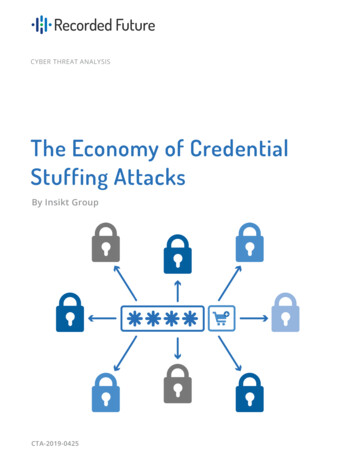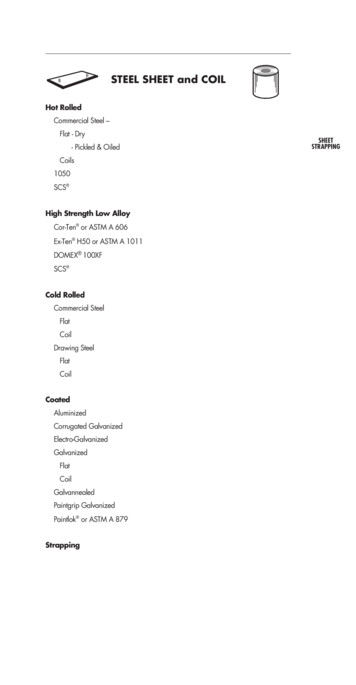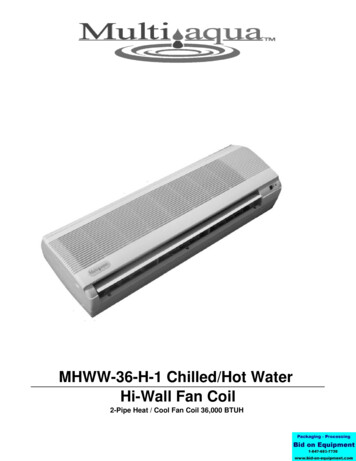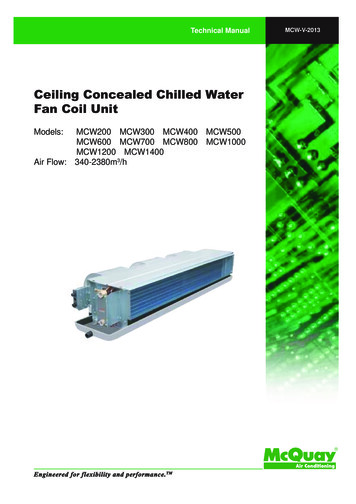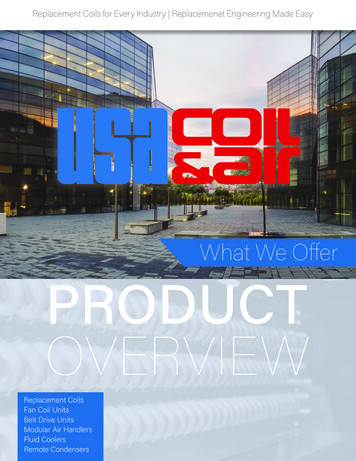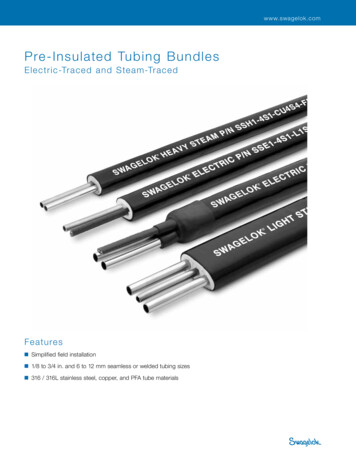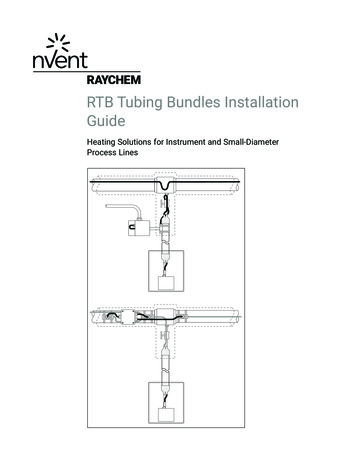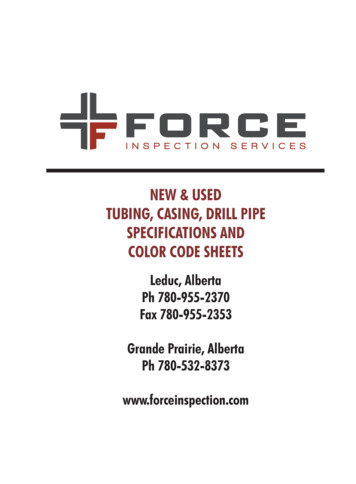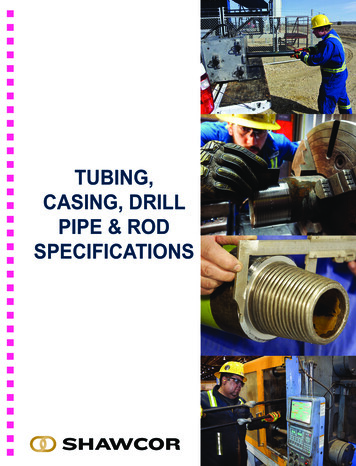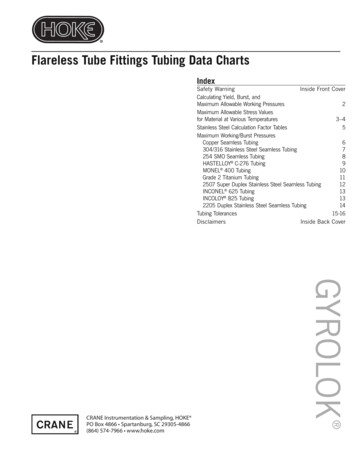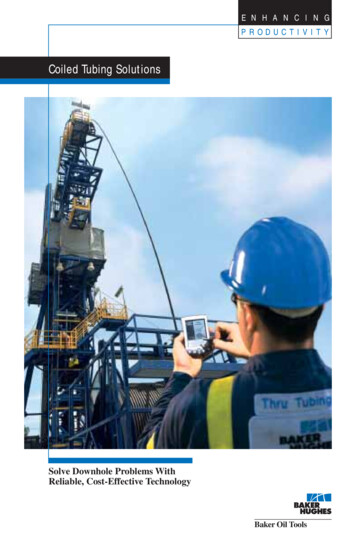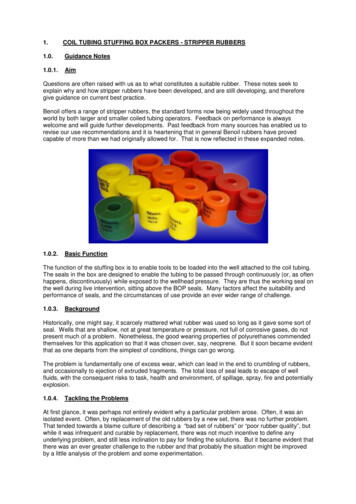
Transcription
1.COIL TUBING STUFFING BOX PACKERS - STRIPPER RUBBERS1.0.Guidance Notes1.0.1.AimQuestions are often raised with us as to what constitutes a suitable rubber. These notes seek toexplain why and how stripper rubbers have been developed, and are still developing, and thereforegive guidance on current best practice.Benoil offers a range of stripper rubbers, the standard forms now being widely used throughout theworld by both larger and smaller coiled tubing operators. Feedback on performance is alwayswelcome and will guide further developments. Past feedback from many sources has enabled us torevise our use recommendations and it is heartening that in general Benoil rubbers have provedcapable of more than we had originally allowed for. That is now reflected in these expanded notes.1.0.2.Basic FunctionThe function of the stuffing box is to enable tools to be loaded into the well attached to the coil tubing.The seals in the box are designed to enable the tubing to be passed through continuously (or, as oftenhappens, discontinuously) while exposed to the wellhead pressure. They are thus the working seal onthe well during live intervention, sitting above the BOP seals. Many factors affect the suitability andperformance of seals, and the circumstances of use provide an ever wider range of challenge.1.0.3.BackgroundHistorically, one might say, it scarcely mattered what rubber was used so long as it gave some sort ofseal. Wells that are shallow, not at great temperature or pressure, not full of corrosive gases, do notpresent much of a problem. Nonetheless, the good wearing properties of polyurethanes commendedthemselves for this application so that it was chosen over, say, neoprene. But it soon became evidentthat as one departs from the simplest of conditions, things can go wrong.The problem is fundamentally one of excess wear, which can lead in the end to crumbling of rubbers,and occasionally to ejection of extruded fragments. The total loss of seal leads to escape of wellfluids, with the consequent risks to task, health and environment, of spillage, spray, fire and potentiallyexplosion.1.0.4.Tackling the ProblemsAt first glance, it was perhaps not entirely evident why a particular problem arose. Often, it was anisolated event. Often, by replacement of the old rubbers by a new set, there was no further problem.That tended towards a blame culture of describing a “bad set of rubbers” or “poor rubber quality”, butwhile it was infrequent and curable by replacement, there was not much incentive to define anyunderlying problem, and still less inclination to pay for finding the solutions. But it became evident thatthere was an ever greater challenge to the rubber and that probably the situation might be improvedby a little analysis of the problem and some experimentation.
The supply of rubbers was dominated by two major companies, Bowen and Texas Oil Tool (TOT),both now part of NOV. There were, and are, others, especially in America, but supply was quitewidespread, including a company in Turkey for example. Most of the rubbers produced by most of thecompanies were of polyurethane, though TOT had some in other materials, such as nitrile andfluorocarbon. Benoil was itself a relative newcomer starting in 1985. It is certain that there werevarious discussions around the industry taking place even before then, though without a positive planto improve rubbers in a concerted way.BP finally decided in about 1990 that they had a significant problem in high pressure dry gas wells.Nowsco (now BJ Services) was invited to organise trials; they used external consultants to design andbuild a test rig, and Benoil were involved in the design and supply of experimental rubbers. Theproducts that resulted formed the first improved Benoil series, as referred to below.These have been further improved upon since then. Subsequent developments have involved makingthe rubbers more temperature resistant for higher temperature (up to 160C) use, and, in contrast,more suitable for very low temperatures (-40C).There is still room, and now demand, for longer life and yet higher temperature and pressure rubberproducts and this is the aim of current developments.1.0.5.Analysis of the ProblemProblems arise from three sources chiefly:mechanical - the system of equipment whatever the rubberphysical- the system/rubber interfacechemical- the nature of the rubberThese interact and are not entirely independent. There is a fourth category, ever potentially present,and that is human error.1.0.5.1. Mechanical EffectsThe most obvious mechanical problem arises if the injector head and the stuffing box are less thanperfectly aligned. If it is slight, it can be difficult to detect, but shows in the unilateral wearing of arubber set. Depending on how the set is aligned in the box, it can affect both halves of a set ofrubbers or just one, but virtually all the wear takes place to one side as that part of the rubber diameteris excessively stressed. In favourable cases this can be seen if the operation is interrupted at asuitable time. We are indebted to PSL, both for samples highlighting a problem and for confirming theinterpretation; in this case, the misalignment was traced to worn parts in one side of the injector head,as shown up through examination of the elastomer pads; when this was rectified, the rubbers in thestuffing box functioned normally. This kind of fault is not really cured by any modification of therubbers; it can still occur.Another mechanical problem may show up if tubing is rusty after a dormant period and is run in thatstate through the stuffing box rubbers. The abrasive nature can play havoc with rubber. This mayoften be only the first few hundred feet of tubing (on the outside of the reel) but it may be enough tocreate initial damage which allows further deterioration by other mechanisms. In the old standardrubbers of the past, this could perhaps be enough to cause rubber failure. This fault too is not curedby rubber modification, but it is ameliorated by the new rubbers. On the other hand, Exxon-Mobilrecently reported some tests in which the surface roughness seemed to play only a minimal role.Other mechanical problems may result from tubing ovality. This we have not been able to pinpoint ashaving an effect on rubber, but it is rather like the misalignment problem; the rubber is always undermore compressive pressure in the direction in which the tubing bulges and under more distortion toseal at right angles. Tubing ovality is not apparently great enough to cause a rubber problem. Were itsevere enough, there would perhaps be other major problems with the tubing. But it undoubtedlyaccentuates a wear problem.The final mechanical problem is the friction problem of running the tubing, but as this is much more aneffect of tubing-rubber interaction, it is considered among the physical effects.
1.0.5.2. Physical EffectsOne could take the view that if the box was energised to something very high, say 8000psi, this wouldvery definitely seal the rubbers around the tubing and one would not have leaks. This is notnecessarily the case, however, and it was a problem with old standard rubbers which simply broke upand wore away. It is also clearly wasteful of pressure pumping capacity and injector head energyneeds on the majority of wells.The problem lies in the frictional interaction between rubber and steel. This is in two forms, dynamicand static. Static friction is particularly significant in causing initial damage to rubbers which, with oldertype rubbers in a dry state, could be ruinous. We know that the effect of pressurising the box is toseal the two rubber halves to each other, on to the tubing and on to the walls of the box; the rubber“grabs on” to the steel. On start up, the tubing has to overcome this static friction, which in effect pullsat the rubber; if squeezed under pressure to ensure a seal this means that the rubber is distorted inthe direction of pull. Of course it is restrained by anti-extrusion rings or brass bushes which areclosely fitted to the tubing, but that initial movement can pick at the rubber surface. The distortion canbe maintained even by the lower dynamic friction, and the rubber wears differentially, top to bottom,giving a well-recognised funnel-shaping to the rubbers.Such an effect is inherent. High squeezing pressures are likely to make it worse. Rusty tubing maymake it worse. But it can be contained.Lubrication - ExternalOne obvious treatment is to ensure clean smooth tubing and lubricate it. This does give animprovement, but it is not easy (from experience) to get enough of the lubrication where it is needed.If the tubing is pre-lubricated, the rubber acts as a wiper to remove much of it before it can affect thedesired interface. If the tubing is pressure lubricated, it is better - this is done in a tandem boxarrangement; but it tends to lubricate only the lower box while running in or the upper while pulling out.The other rubber wears much as if it were not pressure lubricated. It also requires better than averagelubricants, able to withstand high temperature; otherwise they too-readily volatilise and escape orbreak down and cause gumming problems.Lubrication - InternalAn alternative solution is to lubricate the rubber internally. This is Benoil’s preferred approach andwhat is incorporated in our current range. This proved quite problematic in itself even if the principlewas clear; most of the obvious simple candidates did not actually work unless present in such quantitythat they were either uneconomic and/or disruptive of the elasticity of the rubber. For example, arubber containing PTFE was found to break apart with an appearance like shattered flint in somecircumstances; graphite gave a fairly similar result. This made them worse than useless. The finallychosen and effective additive is a proprietary mixture.The resulting rubbers have the characteristic of not binding to the steel tubing, or at least not to thesame degree, which greatly reduces much of the wear problem. It therefore also has the effect ofwearing more smoothly on average, which means that the rate of loss of rubber is more readilyallowed for. This is particularly important in high temperature and high pressure wells, or in fasttripping which tends to generate high temperature. It is also important in deep or long reach wells. Inall cases, one seeks to avoid the cost of stoppage time.This could be important too if coil tubing were used more in mining techniques, where considerableamounts of dust would be likely to be present in the atmosphere and could get on the surface of thecoil before it was run in. If coil tubing is rusty or pitted or rough from other reasons (such as ice in theArctic, say), it will tend to wear the rubbers faster than if it is clean and smooth. But the smooth rate ofwear gives reliable operation. One user informed us he had had no significant stripper rubberproblems since adopting Benoil’s new rubber formulation, over several years’ use; in fairness, he laterthhad a problem run in the 12 year.Lubrication - Complementary
It is, of course, perfectly possible to have both internal and external lubrication. Usually this can beadvantageous. However, be sure to choose a lubricant which does not itself de-grade, or causedegradation of the rubbers. It must again be pointed out that diesel oil is one of the few items knownto seriously swell, and so cause deterioration of, polyurethanes and must on no account be used. Wefound and have reported this before, but are grateful to a customer for a report which dramaticallyconfirmed this.
1.0.5.3. Chemical EffectsIt was stated earlier that effects interact. This is certainly true of the chemical and physical aspects ofthe rubbers used. It is true even within a rubber type.PolyurethaneIt may not be apparent to those involved with CT operations that the term polyurethane covers a verywide class of materials. There are many types and to some extent within broad limits they can betailored to order. Some are hydrolysable and unsuitable for long term use in water, acids or alkalis,but suitable in oil. Others are resistant to such hydrolysis and oil, but less tough. Some are hard andrigid, some are rubbery, some are so soft as to be gelled liquid, some are foams, and so on. Differentbase chemicals can be cross-reacted and formulated in achieving desired results.The variety is almost infinite. For this reason it is well-nigh impossible to achieve an absolutelyidentical result to match competitor products. Years ago when systems were simpler and there werefewer choices, they were at least more alike.Stage 1.When Benoil first made stripper rubbers, we chose materials which were not hydrolysable or likely todeteriorate in oil. We chose two polyurethane systems at 75A and 90A hard (our 3200 and 3100series). Hardness is a good broad indicator of variation within a system, as well as useful in thechosen product. From the graphs of the variation of hardness with temperature (Figure 1.), one seesthat the hardness of both falls slowly away to a critical point and then drops rapidly away as thecompounds break down; this is a chemical breakdown of the polymer and is irreversible once beyondthe critical point. The harder rubber is clearly stable to a higher temperature (about 110C) than thesofter (about 90C).Such graphs must be viewed with care and not taken out of context. Comparison with others done atdifferent times must be particularly cautious unless there is an internal standard in the testing to showthat results can be compared. One of the chief variations is time, which does not appear within thegraph, but forms an important component in later comparisons.
Stage 2.With the proprietary additive included (as described above under physical effects) these polymersbecame much smoother in their wearing behaviour. In the process they also became more stable atslightly higher temperature and pressure. Although we were loo
world by both larger and smaller coiled tubing operators. Feedback on performance is always welcome and will guide further developments. Past feedback from many sources has enabled us to revise our use recommendations and it is heartening that in general Benoil rubbers have proved capable of more than we had originally allowed for. That is now reflected in these expanded notes. 1.0.2. Basic .
